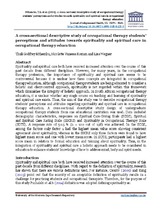| dc.contributor.author | Mthembu, Thuli Godfrey | |
| dc.contributor.author | Roman, Nicolette V. | |
| dc.contributor.author | Wegner, Lisa | |
| dc.date.accessioned | 2018-07-12T08:38:06Z | |
| dc.date.available | 2018-07-12T08:38:06Z | |
| dc.date.issued | 2016 | |
| dc.identifier.citation | Mthembu, T.G. et al. (2016). A cross-sectional descriptive study of occupational therapy students’ perceptions and attitudes towards spirituality and spiritual care in occupational therapy education. Journal of religion and Health, 55: 1529 – 1545. | en_US |
| dc.identifier.issn | 0022-4197 | |
| dc.identifier.uri | http://dx.doi.org/10.10.1007/s1094-015-0125-3 | |
| dc.identifier.uri | http://hdl.handle.net/10566/3876 | |
| dc.description.abstract | Spirituality and spiritual care both have received increased attention over the course of this past decade from different disciplines. However, for many years, in the occupational therapy profession, the importance of spirituality and spiritual care seems to be controversial because it is unclear how these concepts are integrated in occupational therapy education. Although occupational therapy students are being educated to consider a holistic and client-centred approach, spirituality is not regarded within this framework which diminishes the integrity of holistic approach. In South African occupational therapy education, it is unclear whether any single course on teaching and learning of spirituality and spiritual care exists. Thus, the aim of this study was to describe occupational therapy students’ perceptions and attitudes regarding spirituality and spiritual care in occupational therapy education. A cross-sectional descriptive study design of undergraduate occupational therapy students from one educational institution was used. Data included demographic characteristics, responses on Spiritual Care-Giving Scale (SCGS), Spiritual and Spiritual Care Rating Scale (SSCRS) and Spirituality in Occupational Therapy Scale (SOTS). A response rate of 50.5 % (n = 100 out of 198) was achieved. In the SCGS, among the factors only factor 1 had the highest mean value score showing consistent agreement about spirituality, whereas in the SSCRS only three factors were found to have highest mean score and one with lowest mean score. In SOTS, participants had a highest score mean in relation to formal education and training about spirituality. Thus, in the integration of spirituality and spiritual care a holistic approach needs to be considered in education to enhance students’ knowledge of how to address mind, body and spirit needs. | en_US |
| dc.language.iso | en | en_US |
| dc.publisher | Springer | en_US |
| dc.rights | This is the author-version of the article published online at: http://dx.doi.org/10.10.1007/s1094-015-0125-3 | |
| dc.subject | Occupational therapy | en_US |
| dc.subject | Perception | en_US |
| dc.subject | Spirituality | en_US |
| dc.subject | Education | en_US |
| dc.subject | Students | en_US |
| dc.title | A cross-sectional descriptive study of occupational therapy students’ perceptions and attitudes towards spirituality and spiritual care in occupational therapy education | en_US |
| dc.type | Article | en_US |
| dc.privacy.showsubmitter | FALSE | |
| dc.status.ispeerreviewed | TRUE | |
| dc.description.accreditation | ISI | |

